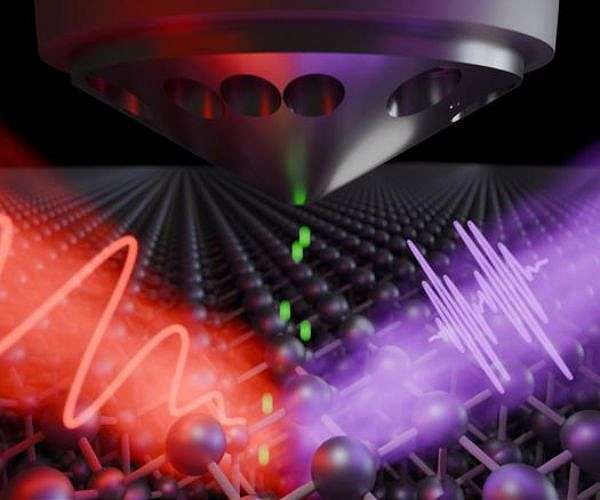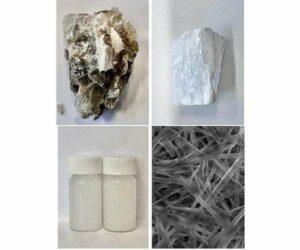
by Robert Schreiber
Oldenburg, Germany (SPX) Jan 10, 2024
Researchers from Sweden and Germany, including Dr. Jan Vogelsang from the University of Oldenburg, have made significant strides in the study of ultrafast electron dynamics. Their work, which tracked the motion of electrons on the surface of zinc oxide crystals with unprecedented spatial and temporal resolution, marks a notable advancement in the field.
This investigation, part of the rapidly evolving domain of ultrafast electron dynamics, employed laser pulses to observe electron movement within nanomaterials. The team's experiments, detailed in the science journal Advanced Physics Research, demonstrate the potential of their approach in understanding electron behavior in applications ranging from nanomaterials to novel solar cell technologies.
Central to their success was the innovative combination of photoemission electron microscopy (PEEM) and attosecond physics technology. PEEM, a technique used for examining material surfaces, was paired with extremely short-duration light pulses, akin to using a high-speed flash in photography, to excite and subsequently track electrons. "The process is much like a flash capturing a fast movement in photography," Dr. Vogelsang elucidated.
One of the key challenges in this field has been achieving the necessary temporal precision to observe these incredibly rapid electron movements. Electrons, significantly smaller and faster than atomic nuclei, require exceptionally fast measuring techniques. The integration of PEEM with attosecond microscopy, without sacrificing spatial or temporal resolution, was a pivotal achievement. Dr. Vogelsang expressed the team's breakthrough: "We have now finally reached the point where we can use attosecond pulses to investigate in detail the interaction of light and matter at the atomic level and in nanostructures."
The team's experimental approach benefited greatly from a high-powered light source capable of generating 200,000 attosecond flashes per second. This frequency enabled the release of individual electrons from the crystal surface, allowing for an undisturbed study of their behavior. "The more pulses per second you generate, the easier it is to extract a small measurement signal from a dataset," Dr. Vogelsang noted, highlighting the importance of this technological capability.
The research was conducted at Lund University's laboratory in Sweden, led by Professor Dr. Anne L'Huillier, a renowned physicist and one of the three Nobel laureates in physics from the previous year. Lund University's laboratory is among the few in the world equipped for such advanced experiments.
Dr. Vogelsang, who previously worked as a postdoctoral researcher at Lund University, is currently establishing a similar laboratory at the University of Oldenburg. The collaboration between these two institutions is set to continue, with plans to explore electron behavior in various materials and nanostructures.
Since 2022, Dr. Vogelsang has led the Attosecond Microscopy research group at the University of Oldenburg, supported by the German Research Foundation's Emmy Noether Programme. This initiative reflects Germany's commitment to fostering cutting-edge scientific research.
Research Report:Time-resolved photoemission electron microscopy on a ZnO surface using an extreme ultraviolet attosecond pulse pair
Related Links
University of Oldenburg
Stellar Chemistry, The Universe And All Within It
- SEO Powered Content & PR Distribution. Get Amplified Today.
- PlatoData.Network Vertical Generative Ai. Empower Yourself. Access Here.
- PlatoAiStream. Web3 Intelligence. Knowledge Amplified. Access Here.
- PlatoESG. Carbon, CleanTech, Energy, Environment, Solar, Waste Management. Access Here.
- PlatoHealth. Biotech and Clinical Trials Intelligence. Access Here.
- Source: https://www.spacedaily.com/reports/Nanoscale_electron_movement_analysis_using_advanced_light_pulses_999.html
- :has
- :is
- :where
- 000
- 10
- 200
- 2022
- a
- achievement
- achieving
- advanced
- advancement
- akin
- All
- Allowing
- among
- an
- analysis
- and
- applications
- approach
- AS
- At
- atomic
- been
- behavior
- between
- breakthrough
- by
- CAN
- capability
- capable
- Capturing
- cell
- central
- challenges
- chemistry
- collaboration
- combination
- commitment
- conducted
- continue
- Crystal
- Currently
- cutting-edge
- de
- demonstrate
- detail
- detailed
- domain
- dr
- dynamics
- easier
- electrons
- employed
- enabled
- equipped
- establishing
- Ether (ETH)
- evolving
- Examining
- exceptionally
- experimental
- experiments
- explore
- expressed
- extract
- extreme
- extremely
- FAST
- faster
- few
- field
- Finally
- Flash
- For
- fostering
- Foundation
- Frequency
- from
- generate
- generating
- German
- Germany
- greatly
- Group
- Have
- Highlight
- highlighting
- HTML
- http
- HTTPS
- importance
- in
- Including
- incredibly
- individual
- Initiative
- innovative
- institutions
- integration
- interaction
- investigate
- investigation
- IT
- Jan
- journal
- jpg
- Key
- laboratory
- laser
- Led
- Level
- light
- like
- made
- material
- materials
- Matter
- measurement
- measuring
- Microscopy
- more
- motion
- movement
- movements
- much
- Nanomaterials
- necessary
- notable
- noted
- novel
- now
- observe
- of
- on
- ONE
- or
- paired
- part
- per
- photography
- Physics
- pivotal
- plans
- plato
- Plato Data Intelligence
- PlatoData
- Point
- potential
- Precision
- previous
- previously
- process
- Professor
- programme
- pulse
- ranging
- rapid
- rapidly
- reached
- reflects
- release
- Renowned
- report
- require
- research
- research group
- researcher
- researchers
- Resolution
- ROBERT
- s
- sacrificing
- Science
- scientific
- Scientific Research
- Second
- set
- Signal
- significant
- significantly
- similar
- since
- small
- smaller
- solar
- Source
- Spatial
- spx
- strides
- Study
- Subsequently
- success
- such
- Supported
- Surface
- Sweden
- team
- technique
- techniques
- technological
- Technologies
- Technology
- than
- The
- the world
- their
- These
- this
- three
- to
- track
- two
- understanding
- Universe
- university
- unprecedented
- use
- used
- using
- various
- was
- we
- which
- WHO
- with
- within
- without
- Work
- worked
- world
- year
- you
- zephyrnet












